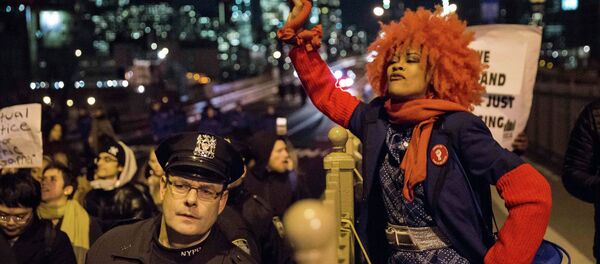MOSCOW, December 23 (Sputnik) — From CIA's torture report, botched lethal injections and US-wide protests over the deaths of unarmed black men to a violent military crackdown in the fledgling Ukrainian democracy to Pakistan's lifting of its years-long execution ban, the outgoing year has seen a lot of human rights challenges that made headlines globally.
CIA torture report
This year's litany of human rights violations has been overshadowed by a scathing December 9 report on the US Central Intelligence Agency (CIA)'s "enhanced interrogation techniques", which has made a big splash internationally and prompted Poland to finally own up to hosting "black site" torture prisons.
In the wake of the release, CIA Director John Brennan assured the nation that torture had helped to save American lives, citing several botched attacks that his agency prevented after they acted on information obtained from al-Qaeda suspects. In reality, none of the clues extracted from the suspects played any role in disrupting terror plots.
The report wrapped up a five-year long investigation into CIA's human rights abuses and has reignited debates about extrajudicial renditions to the United States by America's allies. Poland's former president Aleksander Kwasniewski was the first to admit his government had allowed the CIA to run a secret prison for kidnapped foreigners on Polish soil. Italy, Lithuania, Romania, Sweden and Britain are under scrutiny for working together with the CIA at the height of the Bush administration's war on terrorism from 2002 to 2005.
US anti-police protests and lashback
Running up to the splash made by the CIA torture investigation, the United States had been rocked by a series of protests against police brutality, starting with August civil disorders in a St. Louis suburb of Ferguson, Missouri, which followed the shooting of an unarmed black teenager by a white policeman. Rallies have been ongoing for months, as more and more similar shootings by white police officers of unarmed and allegedly racially-profiled black men came to light.
In August, 18-year-old Michael Brown, an unarmed black man, was shot and killed in Ferguson by white officer Darren Wilson. The shooting and a grand jury's decision not to indict the killer led to months of often-violent rallies. Civic anger at a perception of trigger-happy police and their suspected racial profiling practices did not have time to cool off after a New York grand jury let another white lawman get away with the chokehold death of another unarmed black man, Eric Garner, an asthma patient.
Weeks of nationwide demonstrations led to a disturbing backlash on Sunday when a black man with a background of mental health issues and criminal violations fatally shot two policemen in Brooklyn, New York, allegedly in response to a grand jury's decision to not charge a NYPD officer involved in the death of Eric Garner. The deaths of Asian and Latin American police officers caused an uproar in the community, with police turning their backs on NY Mayor Bill de Blasio at a press conference following the shooting, and candlelit vigils held across the city.
US lethal injection row
The gruesome death of a US death row inmate in Arizona in July helped revive the debate about the death penalty still in force in 32 states, and about the effectiveness of lethal injections. A heated and public debate followed the execution of Joseph Wood, who lived for almost two hours after he was administered 15 doses of lethal drug cocktail, which made him snort and gasp for air.
This string of bungled executions prompted human rights groups to call for the abolishment of capital punishment in the United States, with the Human Rights Watch publishing a report that revealed the "slipshod history" of executions by lethal injection in the country, which, it claimed, followed outdated protocols created with no scientific research three decades ago.
Far from ending the practice, an Ohio Senate passed a bill in December aimed at concealing the names of the pharmaceutical companies that provide drugs for lethal injections. The ruling came after the authority at the Lucasville prison put a convicted killer, Dennis McGuire, to death using a previously untried drug mixture after it failed to procure its first drug of choice. It took McGuire an unexpectedly long time to die and witnesses reported that after receiving the injection he repeatedly gasped and clenched his fists.
Ukrainian military operation and lashback of reporters
Across the Atlantic, Ukraine has been flooded with violence against its own people, as well as international aid workers and journalists who have been killed, assaulted and threatened during their professional activities, starting from the first days of the new regime.
The unrest in the country's east in April led to a massive military crackdown on southeastern Ukrainian regions that have been up in arms against the new government in Kiev, with hundreds of thousands fleeing hostilities over the border into Russia or being internally displaced.
The unrest flared after the coup-installed government in Kiev attempted in spring to scrap a 2012 law that allowed for the use of the Russian language in Russian-majority regions of Crimea and the Southeast, prompting the former to leave Ukraine for Russia after a referendum.
Crimea's reunification with Russia and the Southeast's fight for freedom from Kiev triggered a months-long military operation by the central government that has injured over 10,300 people and killed over 4,700, including 9 journalists, according to UN reports. A journalist NGO with a special UN status put Ukraine on a list of the five most dangerous places for reporters.
Among those killed in Ukrainian hostilities was Andrei Stenin, a photojournalist with Rossiya Segodnya who perished near the south-eastern Ukrainian city of Donetsk after coming under fire from suspected Ukrainian troops. Russian media men Igor Kornelyuk, Anton Voloshin and Anatoly Klyan were also killed in the Ukrainian clashes in 2014.
A November 20 report by the United Nations said it had evidence that the Ukrainian government troops have been using wide-radius cluster munitions in violation of international laws. The organization added that cluster bombs were used in the October 2 shelling of Donetsk by Ukrainian forces that killed a Swiss employee of the Red Cross. Fierce artillery attacks on residential areas in Donetsk and elsewhere in eastern Ukraine have caused a humanitarian crisis and an outflow of refugees, with 400,000 Ukrainians going over to Russia.
Execution ban lifted in Pakistan
Pakistan's decision to drop the execution ban has made Islamabad a target for criticism, with the pressure group Human Rights Watch describing it "a knee-jerk reaction that will result in more needless deaths."
At least 500 death-row inmates could be executed in the country in the coming days, according to media reports, after the government rejected their pleas for mercy. The HRW estimates that some 800 people are currently facing execution in the country for terrorism, with 17,000 still under investigation.






